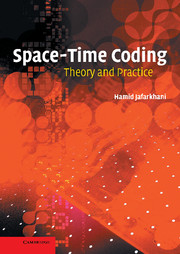Book contents
- Frontmatter
- Contents
- Preface
- Standard notation
- Space-time coding notation
- List of abbreviations
- 1 Introduction
- 2 Capacity of multiple-input multiple-output channels
- 3 Space-time code design criteria
- 4 Orthogonal space-time block codes
- 5 Quasi-orthogonal space-time block codes
- 6 Space-time trellis codes
- 7 Super-orthogonal space-time trellis codes
- 8 Differential space-time modulation
- 9 Spatial multiplexing and receiver design
- 10 Non-orthogonal space-time block codes
- 11 Additional topics in space-time coding
- References
- Index
9 - Spatial multiplexing and receiver design
Published online by Cambridge University Press: 14 August 2009
- Frontmatter
- Contents
- Preface
- Standard notation
- Space-time coding notation
- List of abbreviations
- 1 Introduction
- 2 Capacity of multiple-input multiple-output channels
- 3 Space-time code design criteria
- 4 Orthogonal space-time block codes
- 5 Quasi-orthogonal space-time block codes
- 6 Space-time trellis codes
- 7 Super-orthogonal space-time trellis codes
- 8 Differential space-time modulation
- 9 Spatial multiplexing and receiver design
- 10 Non-orthogonal space-time block codes
- 11 Additional topics in space-time coding
- References
- Index
Summary
Introduction
Using multiple antennas can result in a smaller probability of error for the same throughput because of the diversity gain. The main objective of space-time codes is to achieve the maximum possible diversity. As we have shown in previous chapters, space-time codes provide a diversity gain equal to the product of the number of transmit and receive antennas NM. Also, we have demonstrated that the maximum throughput of the space-time codes is one symbol per channel use for any number of transmit antennas. The use of multiple antennas results in increasing the capacity of MIMO channels as shown in Chapter 2. Therefore, one may transmit at a higher throughput, compared to SISO channels, for a given probability of error. The capacity analysis of Chapter 2 shows that when the number of transmit and receive antennas are the same, the capacity grows at least linearly by the number of antennas. Instead of utilizing the multiple antennas to achieve the maximum possible diversity gain, one can use multiple antennas to increase the transmission rate. In fact, as we discussed in Chapter, there is a trade-off between these two gains from multiple antennas.
One approach to achieve the higher possible throughput is spatial multiplexing (SM). One simple example of spatial multiplexing is when the input is demultiplexed into N separate streams, using a serial-to-parallel converter, and each stream is transmitted from an independent antenna.
- Type
- Chapter
- Information
- Space-Time CodingTheory and Practice, pp. 221 - 250Publisher: Cambridge University PressPrint publication year: 2005
- 1
- Cited by



